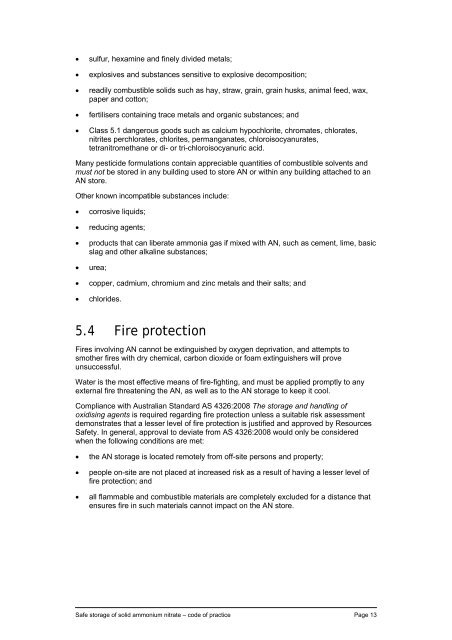Safe storage of solid ammonium nitrate Code of practice
Safe storage of solid ammonium nitrate Code of practice
Safe storage of solid ammonium nitrate Code of practice
You also want an ePaper? Increase the reach of your titles
YUMPU automatically turns print PDFs into web optimized ePapers that Google loves.
• sulfur, hexamine and finely divided metals;<br />
• explosives and substances sensitive to explosive decomposition;<br />
• readily combustible <strong>solid</strong>s such as hay, straw, grain, grain husks, animal feed, wax,<br />
paper and cotton;<br />
• fertilisers containing trace metals and organic substances; and<br />
• Class 5.1 dangerous goods such as calcium hypochlorite, chromates, chlorates,<br />
nitrites perchlorates, chlorites, permanganates, chloroisocyanurates,<br />
tetranitromethane or di- or tri-chloroisocyanuric acid.<br />
Many pesticide formulations contain appreciable quantities <strong>of</strong> combustible solvents and<br />
must not be stored in any building used to store AN or within any building attached to an<br />
AN store.<br />
Other known incompatible substances include:<br />
• corrosive liquids;<br />
• reducing agents;<br />
• products that can liberate ammonia gas if mixed with AN, such as cement, lime, basic<br />
slag and other alkaline substances;<br />
• urea;<br />
• copper, cadmium, chromium and zinc metals and their salts; and<br />
• chlorides.<br />
5.4 Fire protection<br />
Fires involving AN cannot be extinguished by oxygen deprivation, and attempts to<br />
smother fires with dry chemical, carbon dioxide or foam extinguishers will prove<br />
unsuccessful.<br />
Water is the most effective means <strong>of</strong> fire-fighting, and must be applied promptly to any<br />
external fire threatening the AN, as well as to the AN <strong>storage</strong> to keep it cool.<br />
Compliance with Australian Standard AS 4326:2008 The <strong>storage</strong> and handling <strong>of</strong><br />
oxidising agents is required regarding fire protection unless a suitable risk assessment<br />
demonstrates that a lesser level <strong>of</strong> fire protection is justified and approved by Resources<br />
<strong>Safe</strong>ty. In general, approval to deviate from AS 4326:2008 would only be considered<br />
when the following conditions are met:<br />
• the AN <strong>storage</strong> is located remotely from <strong>of</strong>f-site persons and property;<br />
• people on-site are not placed at increased risk as a result <strong>of</strong> having a lesser level <strong>of</strong><br />
fire protection; and<br />
• all flammable and combustible materials are completely excluded for a distance that<br />
ensures fire in such materials cannot impact on the AN store.<br />
<strong>Safe</strong> <strong>storage</strong> <strong>of</strong> <strong>solid</strong> <strong>ammonium</strong> <strong>nitrate</strong> – code <strong>of</strong> <strong>practice</strong> Page 13

















